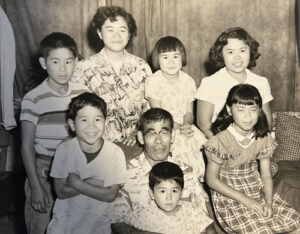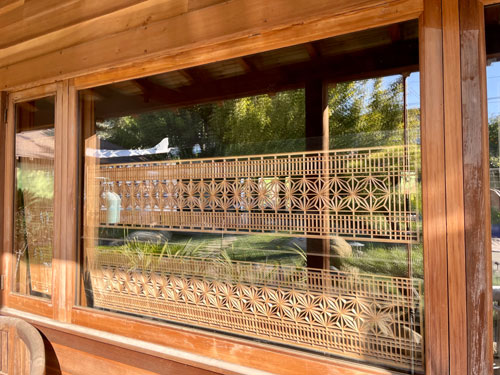Exhibit: Santa Barbara Asian American & Pacific Islander Heritage, 1870s-1970s
Theodore Tomio Muneno (1945- )
Gifted Woodworker and Community Builder
By Mary Hancock

The Muneno Family, ca. 1953. Clockwise from top left: Donald, Jeanne, Patricia, Judith, Carolyn, Daizo, Stevie, Ted. (Courtesy of Ted Muneno)
Family History
Theodore, known as Ted, was the fifth of six children born to Daizo Muneno and Tomiye (Watanabe) Muneno. Daizo’s parents had emigrated from Japan to the island of Hawai’i in the late 19th century and Daizo was born in Ookala in 1898 and later worked on the Kaiwiki Sugar Company’s plantation. He arrived in California in 1920 and worked on farms in San Joaquin County until 1933, when he moved to Santa Barbara County. He worked as a gardener and married Tomiye Watanabe in the mid-1930s. Tomiye was the daughter of Matakichi and Kima Watanabe, who had emigrated to California in the early 20th century. Tomiye worked in the Watanabe Grocery, a provision store started by her father during his final illness to ensure the family’s support. Matakichi died in 1931 at the age of 49. Daizo and Tomiye resided with Tomiye’s mother, Kima, on Canon Perdido Street, near the family’s store. Their first child, a daughter, Jeanne Chiye, was born in 1938, followed by two other children, Judith Setsuko and Donald Kazutoshi.

Ted in the backyard of the family home, ca. 1953. (Courtesy of Ted Muneno)
Detention
In 1942, the family was detained and forced to relocate inland, first to the Assembly Center in Tulare, California and then to the Gila River Relocation Center in Arizona. While in detention, two other children were born–Theodore Tomio, in 1945, and Carolyn Reiko, in 1943. The family returned to Santa Barbara in 1945 and, two years later, a sixth child, Patricia, was born.
Return to Santa Barbara
The Muneno family resettled in a home at 22 Milpas Street that that had been acquired before the war by the family in Tomiye’s name. They were fortunate in having a neighbor, the owner of a nearby business, who had taken care of the property while they were in detention. Ted recalls that the neighbor, Henry Frank, had rented out the home and, after covering property taxes, had returned the rental proceeds to the family, helping them to get back on their feet.
Back in Santa Barbara, Daizo resumed his work as a gardener and Tomiye worked as a housekeeper. They moved to a home on De La Guerra Street in 1953, where they were joined by Tomiye’s sister, Amy Hirada, and her son, Stevie, while Amy’s husband, Louis, served in the US Army in Korea. After Louis lost his life in Korea, Amy and Stevie remained in Santa Barbara with the Munenos. Ted, his siblings and Stevie attended Santa Barbara schools and Ted helped with his father’s gardening business. Ted remembers the bonds that linked the Nisei generation through camping trips and outings hosted by both Buddhist and Christian churches and occasional movie nights at the Buddhist Church. Ted also remembers his work at a local gas station being enlivened by the elder Issei generation who gathered in the station’s back room to swap stories and reminisce.
Ted graduated from high school in 1963 and was drafted into the Army, working as a mechanic from 1966 to 1968. In 1975, he married Naomi Nakamura, and they joined the extended family household on De La Guerra Street. Eventually, Ted built a separate home and workshop in the rear of the compound, both graced by Japanese architectural detail. Naomi worked in Von’s grocery store in Montecito, eventually completing 40 years with the company.
Becoming a Woodworker

Window Screens made by George Nishihara at the Muneno home (Courtesy of Melinda Yamane Crawford)
Ted’s path to his career as a woodworker was serendipitous. After his discharge from the Army, he sold his prized Camaro and purchased an Econoline van, which he decided to convert into a camper: “I wanted to drop out and be a hippie!” He asked for advice on the carpentry for the van’s conversion from family friend, George Nishihara, who had established a woodworking business in Santa Barbara after training in Japan as a shoji maker. In the course of working with George, whom he admired and respected, Ted found that he had a knack for woodworking and began an apprenticeship, eventually becoming a skilled woodworker and building a local clientele. He took over the business upon George’s retirement, but recalls that George continued to guide him, coming to the shop regularly for years after retirement to advise and help with projects. The shop specialized in custom cabinetry and eventually furniture making, much of it inflected by Japanese design principles and style. His success also enabled him to buy back and restore his Camaro to its original pristine condition!
Research for a wood-working project gave Ted his first opportunity to visit Japan. Later, he and Naomi made another trip with a group organized by the San Luis Obispo Buddhist Church. These visits were cherished opportunities to reunite with family members, discover new connections and make new memories. And Ted’s artistry will inspire new memories for many in Santa Barbara — from the homes graced by his cabinets and furniture, to the Torii Gate that he designed for Santa Barbara’s waterfront and that now stands as an expression of friendship between Santa Barbara and its sister city of Tuba, Japan.

Torii Gate at the Santa Barbara Waterfront, designed by Ted Muneno. (Courtesy of Ted Muneno)
Acknowledgements
Warm thanks to Ted Muneno and Jeanne Muneno Gray for sharing their stories, family photographs, and personal memoirs.
References
Daizo Muneno, 1920. “California, San Francisco Passenger Lists, 1893-1953,” San Francisco, San Francisco, California, United States, NARA microfilm publication M1410 (Washington, D.C.: National Archives and Records Administration, n.d.); FHL microfilm 1,465,699.
Daizo Muneno, 1942-1946. “United States Japanese Americans Relocated During World War II, 1942-1946”, database accessed through FamilySearch (https://www.familysearch.org/ark:/61903/1:1:KX28-4H6 : 13 June 2022),
Daizo Muneno. Final Accountability rosters of evacuees at Relocation Centers; Gila River, Nov. 1945. “United States, War Relocation Authority centers, final accountability rosters, 1942-1946,” NARA microfilm publication M1865 (Washington D.C.: National Archives and Records Administration, 2001).
Jeanne Muneno Gray. Interview with Melinda Yamane Crawford. Santa Barbara, California. April 23, 2023.
Theodore Muneno and Naomi Nakamura, 28 June 1975.”California Marriage Index, 1960-1985,” Santa Barbara, California, Center of Health Statistics, California Department of Health Services, Sacramento
